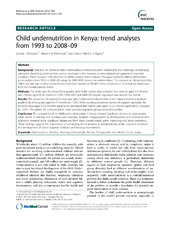| dc.contributor.author | Matanda, Dennis Juma | |
| dc.contributor.author | Mittelmark, Maurice B. | |
| dc.contributor.author | Kigaru, Dorcus Mbithe D. | |
| dc.date.accessioned | 2014-02-17T08:31:43Z | |
| dc.date.available | 2014-02-17T08:31:43Z | |
| dc.date.issued | 2014-01-13 | eng |
| dc.identifier.issn | 1471-2431 | |
| dc.identifier.uri | https://hdl.handle.net/1956/7798 | |
| dc.description.abstract | Background: Research on trends in child undernutrition in Kenya has been hindered by the challenges of changing criteria for classifying undernutrition, and an emphasis in the literature on international comparisons of countries’ situations. There has been little attention to within-country trend analyses. This paper presents child undernutrition trend analyses from 1993 to 2008–09, using the 2006 WHO criteria for undernutrition. The analyses are decomposed by child’s sex and age, and by maternal education level, household Wealth Index, and province, to reveal any departures from the overall national trends. Methods: The study uses the Kenya Demographic and Health Survey data collected from women aged 15–49 years and children aged 0–35 months in 1993, 1998, 2003 and 2008–09. Logistic regression was used to test trends. Results: The prevalence of wasting for boys and girls combined remained stable at the national level but declined significantly among girls aged 0–35 months (p < 0.05). While stunting prevalence remained stagnant generally, the trend for boys aged 0–35 months significantly decreased and that for girls aged 12–23 months significantly increased (p < 0.05). The pattern for underweight in most socio-demographic groups showed a decline. Conclusion: The national trends in childhood undernutrition in Kenya showed significant declines in underweight while trends in wasting and stunting were stagnant. Analyses disaggregated by demographic and socio-economic segments revealed some significant departures from these overall trends, some improving and some worsening. These findings support the importance of conducting trend analyses at detailed levels within countries, to inform the development of better-targeted childcare and feeding interventions. | en_US |
| dc.language.iso | eng | eng |
| dc.publisher | BioMed Central | eng |
| dc.relation.ispartof | <a href="http://hdl.handle.net/1956/9606" target="blank">Child Physical Growth and Care Practices in Kenya: Evidence from Demographic and Health Surveys</a> | eng |
| dc.rights | Attribution CC BY | eng |
| dc.rights.uri | http://creativecommons.org/licenses/by/2.0/ | eng |
| dc.subject | Undernutrition | eng |
| dc.subject | Wasting | eng |
| dc.subject | Stunting | eng |
| dc.subject | Underweight | eng |
| dc.subject | Trends | eng |
| dc.subject | Demographic and Health Survey | eng |
| dc.subject | Kenya | eng |
| dc.title | Child undernutrition in Kenya: trend analyses from 1993 to 2008-09 | eng |
| dc.type | Peer reviewed | |
| dc.type | Journal article | |
| dc.date.updated | 2014-01-21T12:10:14Z | |
| dc.description.version | publishedVersion | |
| dc.description.version | Peer Reviewed | |
| dc.rights.holder | Copyright 2014 Matanda et al.; licensee BioMed Central Ltd. | |
| dc.rights.holder | Dennis J Matanda et al.; licensee BioMed Central Ltd. | eng |
| dc.source.articlenumber | 5 | |
| dc.identifier.doi | https://doi.org/10.1186/1471-2431-14-5 | |
| dc.identifier.cristin | 1126775 | |
| dc.source.journal | BMC Pediatrics | |
| dc.source.40 | 14 | |

